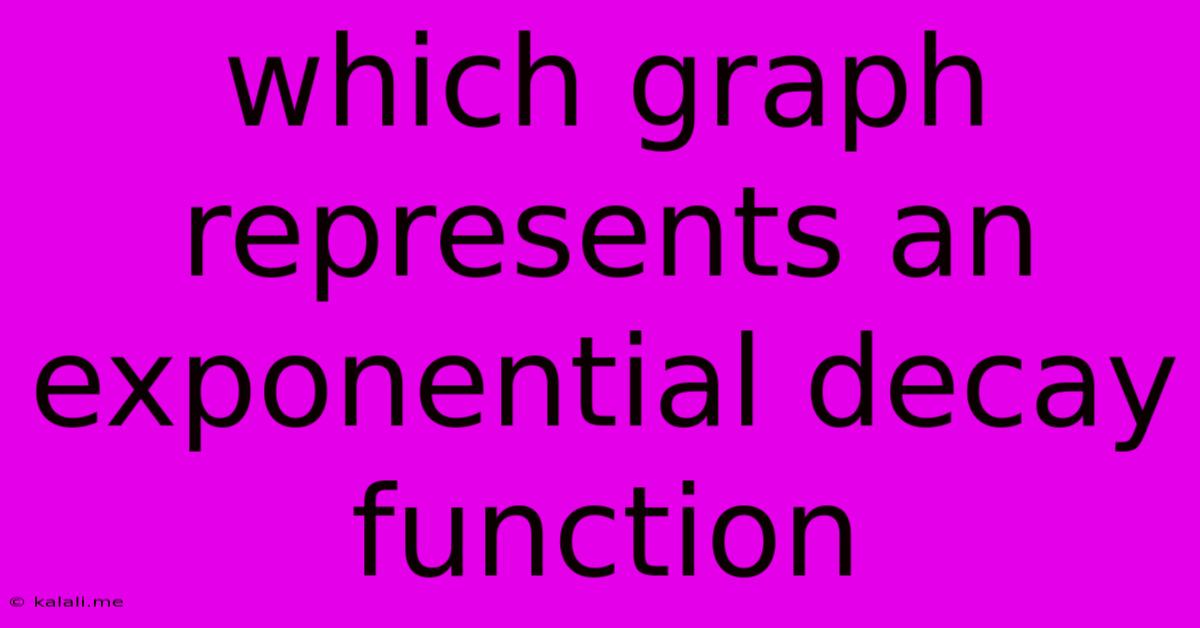Which Graph Represents An Exponential Decay Function
Kalali
May 08, 2025 · 3 min read

Table of Contents
Which Graph Represents an Exponential Decay Function?
Understanding exponential decay is crucial for anyone working with data analysis, modeling real-world phenomena, or simply grasping fundamental mathematical concepts. This article will delve into identifying the characteristic graph of an exponential decay function, clarifying its key features and differentiating it from other function types. We'll explore its equation, common applications, and how to spot it visually.
What is Exponential Decay?
Exponential decay describes a decrease in a quantity over time, where the rate of decrease is proportional to the current value. This means the larger the quantity, the faster it decreases. Unlike linear decay, where the decrease is constant, exponential decay shows a progressively slower decline. The process is governed by a constant decay rate, often expressed as a percentage or a fraction.
The Equation of Exponential Decay
The general equation for exponential decay is:
y = A * e^(-kt)
Where:
yis the final amount or value after timetAis the initial amount or value at time t=0kis the decay constant (a positive number)eis Euler's number (approximately 2.71828)tis time
The decay constant, k, determines the speed of the decay. A larger k means faster decay. You might also see this equation represented using a base other than e, such as:
y = A * b^(-kt) where b is a positive constant less than 1.
Identifying the Graph of Exponential Decay
The graph of an exponential decay function exhibits several key characteristics:
- Starts high, decreases asymptotically: The graph begins at the initial value (A) on the y-axis and gradually decreases towards zero as time (x-axis) increases. It never actually reaches zero; it approaches it asymptotically.
- Always positive: The y-values are always positive, as you can't have a negative amount of something decaying.
- Concave up: The graph curves upward, meaning the rate of decrease slows down over time. This is in contrast to a linear decay function, which would have a straight line graph.
- Smooth and continuous: There are no breaks or jumps in the graph; it's a smooth, continuous curve.
Distinguishing Exponential Decay from Other Functions
It's important to differentiate exponential decay from other functions that might look similar:
- Linear Decay: A straight line with a negative slope. The rate of decrease is constant.
- Exponential Growth: A mirror image of exponential decay; it starts low and increases rapidly.
- Power Functions: These functions exhibit different decay patterns; they might decrease quickly initially, then slow down, but their shape differs from exponential decay.
Real-World Applications of Exponential Decay
Exponential decay models numerous real-world phenomena, including:
- Radioactive decay: The decay of radioactive isotopes over time.
- Drug metabolism: The elimination of a drug from the body.
- Cooling of objects: Newton's Law of Cooling describes the exponential decay of temperature difference.
- Atmospheric pressure: Pressure decreases exponentially with altitude.
- Capacitor discharge: The discharge of a capacitor in an electrical circuit.
In Conclusion
Recognizing the graph of an exponential decay function involves understanding its key features: its starting point, asymptotic approach to zero, concave-up shape, and always positive y-values. By understanding its equation and contrasting it with other function types, you can confidently identify and interpret exponential decay in various contexts. Remembering these visual and mathematical characteristics will greatly enhance your ability to analyze and model real-world scenarios where exponential decay plays a significant role.
Latest Posts
Latest Posts
-
How Tall Is A Average 14 Year Old
May 09, 2025
-
Cuanto Son 15 Pies En Metros
May 09, 2025
-
How Many Cm In 56 Inches
May 09, 2025
-
6 Of 25 Is What Percent
May 09, 2025
-
156 Out Of 200 As A Percentage
May 09, 2025
Related Post
Thank you for visiting our website which covers about Which Graph Represents An Exponential Decay Function . We hope the information provided has been useful to you. Feel free to contact us if you have any questions or need further assistance. See you next time and don't miss to bookmark.